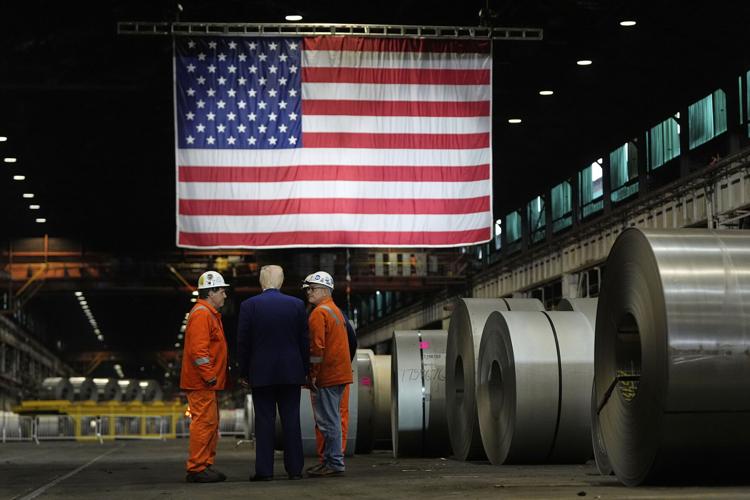WASHINGTON — As President Donald Trump prepares to announce new tariff increases, the costs of his policies are starting to come into focus for a domestic manufacturing sector that depends on global supply chains, with a new analysis suggesting factory costs could increase by about 2% to 4.5%.
"There's going to be a cash squeeze for a lot of these firms," said Chris Bangert-Drowns, the researcher at the Washington Center for Equitable Growth who conducted the analysis. Those seemingly small changes at factories with slim profit margins, Bangert-Drowns said, "could lead to stagnation of wages, if not layoffs and closures of plants" if the costs are untenable.
The analysis, released Tuesday, points to the challenges Trump might face in trying to sell his tariffs to the public as a broader political and economic win and not just as evidence his negotiating style gets other nations to back down.
People are also reading…

President Donald Trump talks to workers May 30 as he tours U.S. Steel Corporation's Mon Valley Works-Irvin plant in West Mifflin, Pa.
The success of Trump's policies ultimately depends on whether everyday Americans become wealthier and factory towns experience revivals, a goal outside economists say his Republican administration is unlikely to meet with tariffs.
Trump announced new frameworks with the European Union, Japan, the Philippines, Indonesia and Britain that would each raise the import taxes charged by the United States. He's prepared to levy tariffs against goods from dozens of other countries starting Friday in the stated range of 15% to 50%.
Trump claims the tariff revenues will whittle down the budget deficit and help whip up domestic factory jobs, all while playing down the risks of higher prices.
"We've wiped out inflation," Trump said last Friday before boarding Marine One while on his way to Scotland.

President Donald Trump speaks during an April 2 event to announce new tariffs in the Rose Garden at the White House in Washington.
Consumer prices rose 2.7% in June from a year earlier, up from an annual increase of 2.4% in May.
There's the possibility of backlash in the form of higher prices and slower growth once tariffs flow more fully through the world economy.
A June survey by the Atlanta Federal Reserve suggested companies would on average pass half of their tariff costs onto U.S. consumers through higher prices.
Labor Department data shows America lost 14,000 manufacturing jobs after Trump rolled out his April tariffs, putting a lot of pressure as to whether a rebound starts in the June employment report coming out Friday.
New costs for factories
The Washington Center for Equitable Growth analysis shows how Trump's devotion to tariffs carries potential economic and political costs for his agenda. In the swing states of Michigan and Wisconsin, more than 1 in 5 jobs are in the critical sectors of manufacturing, construction, mining and oil drilling and maintenance that have high exposures to his import taxes.
The artificial intelligence sector Trump last week touted as the future of the economy is dependent on imports. More than 20% of the inputs for computer and electronics manufacturing are imported, so the tariffs could magnify a hefty multitrillion-dollar price tag for building out the technology in the U.S.
The White House claims American businesses will access new markets because of the trade frameworks, saying companies will benefit as a result.

President Donald Trump and European Commission President Ursula von der Leyen shake hands Sunday after reaching a trade deal at the Trump Turnberry golf course in Turnberry, Scotland.
World economy
There are limits to the analysis. Trump's tariff rates have been a moving target, and the analysis looks only at additional costs, not how those costs will be absorbed among foreign producers, domestic manufacturers and consumers. Also, the legal basis of the tariffs as an "emergency" act goes before a U.S. appeals court on Thursday.
Treasury Secretary Scott Bessent said in an interview last week on Fox Business Network that countries were essentially accepting the tariffs to maintain access to the U.S. market. "Everyone is willing to pay a toll," he said.
But what Bessent didn't say is U.S. manufacturers are also paying much of that toll.
"We're getting squeezed from all sides," said Justin Johnson, president of Jordan Manufacturing Co. in Belding, Michigan, northeast of Grand Rapids. His grandfather founded the company in 1949.
The company, which makes parts used by Amazon warehouses, auto companies and aerospace firms, has seen the price of a key raw material — steel coil — rise 5% to 10% this year.

A cauldron of melted steel moves into position for producing rolls of sheet steel July 25, 2018, at the NUCOR Steel Gallatin plant in Ghent, Ky.
Trump imposed 50% tariffs on imported steel and aluminum. Jordan Manufacturing doesn't buy foreign steel. But by crippling foreign competition, Trump's tariffs allowed domestic U.S. steelmakers to hike prices.
Johnson doesn't blame them. "There's no red-blooded capitalist who isn't going to raise his prices" under those circumstances, he said.
Josh Smith, founder and president of Montana Knife Co., called himself a Trump voter but said he sees the tariffs on foreign steel and other goods as threatening his business.
For instance, Smith just ordered a $515,000 machine from Germany that grinds his knife blades to a sharp edge. Trump had imposed a 10% tax on products from the EU that is set to rise to 15% under the trade framework he announced Sunday. So Trump’s tax on the machine comes to $77,250 — about enough for Smith to hire an entry-level worker.
“The average American is not sitting in the position I am, looking at the numbers I am and making the decisions each day, like, ‘Hey, we cannot hire those extra few people because we might have to pay this tariff on this steel or this tariff on this grinder,'" he said. "I want to buy more equipment and hire more people. That’s what I want to do."












